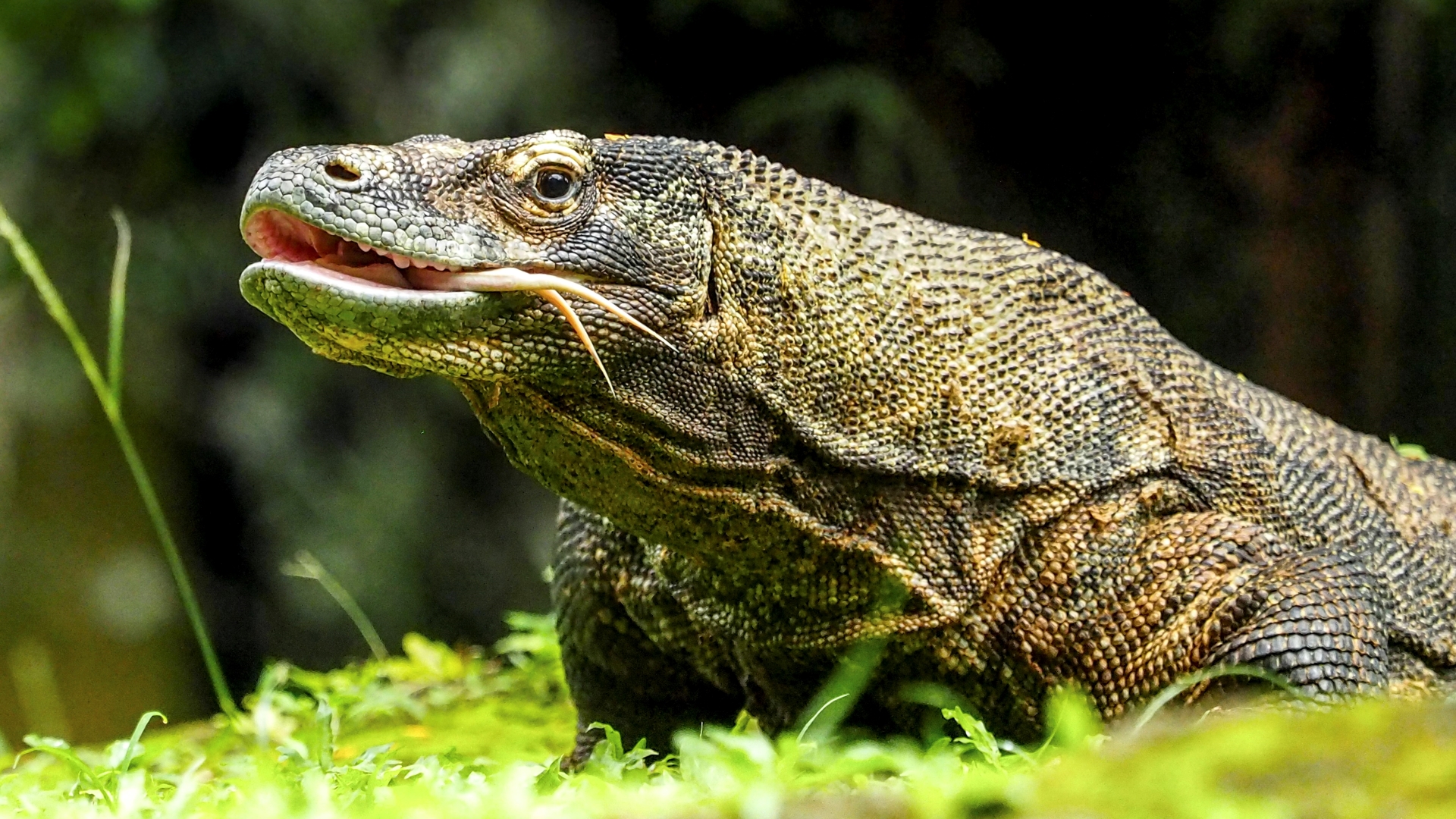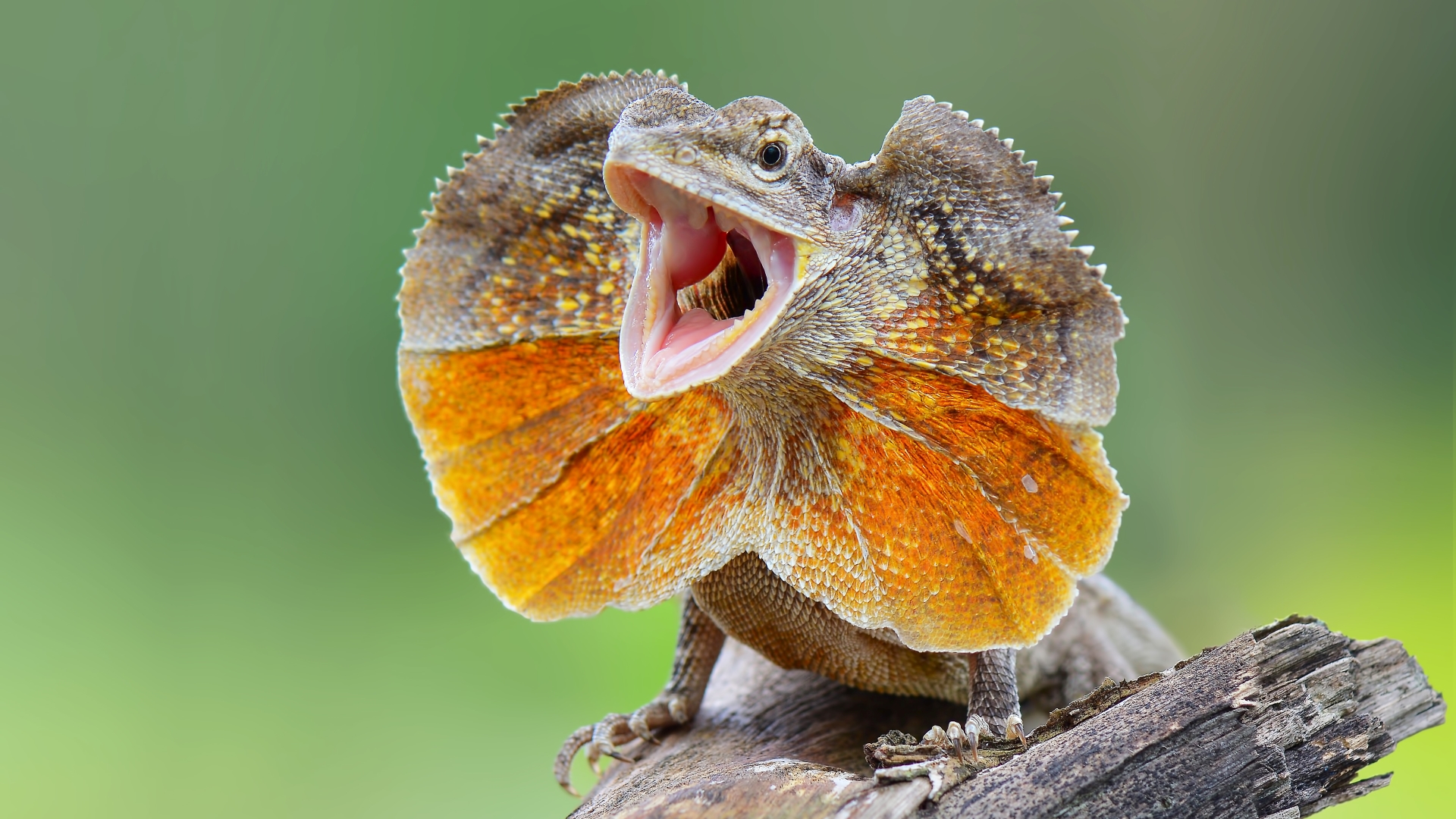Lizards: From tiny geckos to giant Komodo dragons
Lizards run, climb, glide and even walk on water (very quickly).

Lizards are a diverse and ancient group of reptiles that live around the world today. There are thousands of lizard species, and each has special adaptations and traits. There are lizards with frills, lizards with horns, and lizards with wings. Most lizards have four legs, but some get by on two legs and others have no legs at all.
The name "lizard" doesn't correspond to a single scientific group. Lizards belong to the order Squamata, which they share with snakes. There are several subgroups within Squamata that are commonly called lizards, including geckos, iguanas, worm lizards and Autarchoglossa, according to the Integrated Taxonomic Information System (ITIS), a partnership of North American agencies, organizations and taxonomists that provides taxonomic information. All lizards are sometimes grouped under the suborders Lacertilia or Sauria, but ITIS doesn't consider these to be valid scientific groups.
Are lizards dinosaurs?
Though they are reptiles, lizards are not dinosaurs. Body plan, and therefore movement, is a key difference between the two groups. Lizards' legs are sprawled out, and they walk in a side-to-side motion. Dinosaurs, on the other hand, had an upright stance with their legs positioned underneath them, according to the American Museum of Natural History in New York.
Lizards have been around for hundreds of millions of years and lived through multiple mass extinction events, including the asteroid strike that caused the extinction of nonavian dinosaurs 66 million years ago (though avian dinosaurs survived as birds). Lizards likely predate the dinosaurs, which first emerged about 230 million years ago during the Triassic period (251.9 million to 201.3 million years ago).
"Based on a new estimate of the rate of evolution of lizards, we can now place the origin of these reptiles in the late Permian period, about 260 million years ago," Alessandro Palci, a research associate in evolutionary biology at Flinders University in Australia, wrote in The Conversation in 2018.
Related: 'Strange beast' in amber is a very weird lizard

Types of lizards
Lizards come in a variety of shapes, sizes and colors. The largest and heaviest lizards are Komodo dragons (Varanus komodoensis) from Indonesia. They weigh 154 pounds (70 kilograms), on average, and the largest Komodo dragon on record reached 10.3 feet long (3.1 meters), according to the Smithsonian's National Zoo in Washington, D.C.
It's clear that Komodo dragons are the biggest lizards. Because the smallest lizards are so tiny, however, it's harder for scientists to be sure which species is the smallest. Jaragua lizards (Sphaerodactylus ariasae) in the Caribbean held the record for the smallest lizards on Earth when they were described in a 2001 study published in the Caribbean Journal of Science. With an average body length of 0.6 inch (16 millimeters), excluding the tail, the lizards were also smaller than any known bird or mammal at the time.
But a challenger arrived for their tiny crown in 2021, when a chameleon called Brookesia nana in Madagascar was described in a study published in the journal Scientific Reports. B. nana males are smaller than S. ariasae, growing to only about 0.5 inch (13.5 mm). However, the females of this species are longer than Jaragua lizards, at 0.75 inch (19.2 mm).
"Given that the general body plan of reptiles is rather similar to that of mammals and humans, it is fascinating to see how miniaturized these organisms and their organs can get," lead study author Frank Glaw, a herpetologist at the Bavarian State Collection of Zoology in Munich, told Live Science in an email at the time.
Size isn't the only feature that makes some lizard species stand out. Members of the Draco genus are often called "flying dragons" because they glide from tree to tree in Southeast Asia using a thin membrane that stretches between their front and back legs like a pair of flat wings. Meanwhile, basilisk lizards in the genus Basiliscus from Central and South America run so fast on their hind legs that they can run on water, with the help of specialized foot scales. They do this to escape predators, and it's earned them the nickname "Jesus Christ lizard," according to the Smithsonian's National Zoo.
If lizards are nabbed by a predator, they can break off or "drop" their tails to avoid being eaten. They can regrow their tails if this happens, but the new tails aren't perfect copies. The bones in the original tail don't grow back, so the new tails are mostly cartilage, according to a 2015 study published in the journal Developmental Biology.
Related: World's smallest reptile fits on your fingertip
Where do lizards live?
Lizards live all over the world and occupy all kinds of habitats. For example, in North America, Texas horned lizards (Phrynosoma cornutum) spend a lot of their time in loose sands in open, arid or semiarid areas of northern Mexico and the south central U.S., including most of Texas — hence their name, according to the Texas Parks and Wildlife Department. In contrast, eastern fence lizards (Sceloporus undulatus) tend to live in areas with trees. Ranging as far north as New York, as far south as northern Florida, and as far west as Arkansas, these lizards use the trees to escape predators such as snakes and birds, according to the National Wildlife Federation.
Some lizards, such as basilisk lizards, spend a lot of their time in and around water. Lizards usually make use of freshwater habitats, but marine iguanas (Amblyrhynchus cristatus) from the Galápagos Islands dive into the ocean to feed off algae, according to the Natural History Museum in London.
Lizards are ectothermic, which means they rely on the external environment to stay warm and can't regulate their own body temperature as endothermic animals, such as mammals, do. This means that, like frogs and snakes, they are commonly called "cold-blooded." As a result, most lizards are active during the day and can be seen basking in the sun to warm up.
Lizards may be territorial, and they spend most of their time alone or live alongside dozens of other lizards of the same or different species. Lizards typically don't spend time with others of their species, except to mate, but there are exceptions. For example, desert night lizards (Xantusia vigilis) live in family groups, according to research by the University of California, Santa Cruz.
What do lizards eat?
Many lizards eat other animals. Komodo dragons are capable of consuming up to 80% of their body weight in a single sitting and eat other reptiles, birds, eggs and mammals, according to the Zoological Society of London. Some lizards have a much wider diet that includes a mix of meat, insects and vegetation. For example, central bearded dragons (Pogona vitticeps) in Australia eat fruit and leaves, alongside invertebrates such as ants and vertebrates such as smaller lizards, according to the Australian Museum in Sydney. Then there are lizards with specialized herbivorous diets, such as the algae-eating marine iguanas, although they've also been observed eating insects and crustaceans.
Related: Watch: First-ever footage of a lizard breathing underwater

Are lizards poisonous?
Lizards aren't poisonous, or harmful when ingested, but a few species are venomous, meaning they inject harmful venom. For example, Gila monsters (Heloderma suspectum) living in southwestern U.S. states and northwestern Mexico use venom to hunt prey or defend themselves against predators, according to the American Museum of Natural History. A Gila monster may bite onto another animal for several minutes, transferring venom through teeth grooves in its lower jaw. The venom is extremely painful, but not fatal, to humans.
Do lizards lay eggs?
Many lizards lay eggs, and some give birth to live young. Lizard breeding typically begins when a male lizard tries to attract a female mate with a display, sometimes bobbing its head and flashing its colorful neck. Frilled lizards (Chlamydosaurus kingii) from northern Australia and southern New Guinea are so named because of the frills around their necks, which they spread out during mating displays or when they want to scare away predators. These lizards lay up to 23 eggs between November and February and bury them underground, according to the Northern Territory Government in Australia. In contrast, common lizards (Zootoca vivipara), which are found across much of northern Europe, give birth to up to 10 live young in July, according to the Woodland Trust, a woodland conservation charity in the U.K.
Most baby lizards are self-sufficient from birth and can walk, run and feed on their own. Young lizards reach maturity at different ages, ranging from 18 months to 7 years, depending on the species, according to the San Diego Zoo. Lizards' life spans also vary greatly. Labord's chameleons (Furcifer labordi) may live only months in their native habitat of Madagascar, while other lizards can survive for decades. The longest-living lizards, Grand Cayman blue iguanas (Cyclura lewisi) of the Cayman Islands, often live more than 50 years. One captive Grand Cayman blue iguana is estimated to have lived 69 years, according to Guinness World Records.
Related: There be dragons: 6-foot-long lizard terrifies Florida family
Are lizards endangered?
The International Union for Conservation of Nature (IUCN) completed a comprehensive assessment of the world's reptiles in 2022 and determined that 21% of reptiles are at risk of extinction, including many lizards. The biggest threats to reptiles around the world are habitat loss due to agricultural expansion, deforestation and urban development.
Both the largest and the smallest lizard species could disappear in the near future. Komodo dragons are endangered because of threats such as residential and commercial development and climate change, according to the IUCN. Meanwhile, the study authors who described B. nana in 2021 recommended that the IUCN list the species as critically endangered because it lives in a small area that's shrinking due to deforestation and agricultural expansion.
The IUCN hasn't yet assessed B. nana, but there are plenty of critically endangered lizards listed on the organization's website, including the Campbell's alligator lizard (Abronia campbelli) from Guatemala, Bojer's skink (Gongylomorphus bojerii) from Mauritius and Atalaye curlytail lizard (Leiocephalus pratensis) from Haiti.
Lizards are popular in the pet trade, which poses a threat to species that are sourced from the wild. Even lizards that are commonly bred in captivity, such as Tokay geckos (Gekko gecko) from Southeast Asia, are sometimes caught in the wild to supply the trade, according to TRAFFIC, a wildlife trade monitoring charity in the U.K.
Additional resources
For a map of where lizards and snakes live around the world, including the U.S., check out the Encyclopedia of Life website. To see how a Draco lizard attracts a mate, watch this short YouTube video from the Smithsonian Channel. To learn more about the different lizard families, check out "Lizards of the World: A Guide to Every Family" (Princeton University Press, 2021).
This article was originally written by Live Science contributor Alina Bradford and has since been updated.
Sign up for the Live Science daily newsletter now
Get the world’s most fascinating discoveries delivered straight to your inbox.

Patrick Pester is the trending news writer at Live Science. His work has appeared on other science websites, such as BBC Science Focus and Scientific American. Patrick retrained as a journalist after spending his early career working in zoos and wildlife conservation. He was awarded the Master's Excellence Scholarship to study at Cardiff University where he completed a master's degree in international journalism. He also has a second master's degree in biodiversity, evolution and conservation in action from Middlesex University London. When he isn't writing news, Patrick investigates the sale of human remains.










